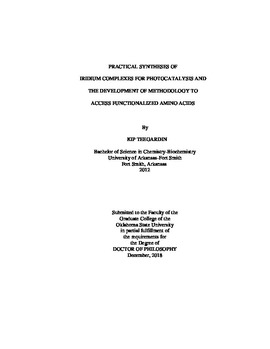| dc.description.abstract | Incorporation of fluorine into molecules can result in enhanced properties of functional molecules in a variety of fields. As such, there is great interest to synthesize organofluorines. The objective of current research efforts is the installation(s) of fluorine into the molecule. This approach faces substantial challenges with both the installation and the C–F bond as well as selectivity. Despite substantial progress, direct fluorination strategies are often unselective. Often the simplest compounds are a challenge to synthesize, which is a requirement for all aryl fluorides given that there are no natural sources. This problem is magnified when multiple fluorines are located on one arene. An alternative approach to the synthesis of multifluorinated arenes is to start with a perfluoroarene, in which every possible position has been fluorinated, and then selectively functionalize the undesired C–F bonds. This approach has been pioneered by Swartz, Milstein, and Aizenberg. More recently, the Weaver group has researched new methodology for the selective removal of fluorine from highly fluorinated arenes. The key C–F fragmentation relies on the visible light mediated photocatalytic electron transfer from a mild tertiary amine reductant. This has been a substantial advancement for the field of C–F functionalization, and has revealed two needs preventing further advancement. Namely, there is a need to increase access to both Ir-based photocatalysts and highly fluorinated building blocks. Notably, thousands of other photocatalytic reactions have emerged utilizing ruthenium and iridium photocatalysts. Since these photocatalysts play a vital role in such reactions, we describe an improved synthesis to a class of homoleptic iridium (III) based complexes that allow rapid access to these compounds in high yields. Using a well-known method, we expanded our photocatalyst library by synthesizing a range of hetereoleptic complexes. Additionally, we report their photophysical and electrochemical properties, calculated excited state properties, and comment on the role of these properties in designing catalytic cycles. Later, we report a modified method which has been applied to homoleptic complexes to obtain multigram quantities of the photocatalyst in high purity, without the use of a column, and with excellent recovery of excess ligand in high yield, substantially enhancing access to this class of photocatalyst. In an application of these complexes, we developed a photocatalytic reductive coupling of aryl bromides with a broad set of alkenes. The reaction takes place via a photocatalytically generated aryl radical which subsequently reacts with an alkene to form a C–C bond. Responding to a need to access more complex fluorinated building blocks, we next developed a method that provided fluorinated amino acid building blocks via nucleophilic aromatic substitution of highly fluorinated (hetero)arenes with an oxazolone enolate. Moreover, we demonstrated the utility in a one pot synthesis of medicinally relevant 2-aminohydantoins. With these amino acids in hand, we further explored the reactivity of the enolate anion generated from the alpha amino esters. We showed that the monoanion enolate was a competent nucleophile that could undergo catalytic Michael addition of α-amino esters. We also provided insight into the governing principles, which resulted in an expansion of the scope. The study concludes with a late-stage functionalization of peptidic γ-secretase inhibitor, DAPT, which highlights the power of the method for direct functionalization of biologically relevant peptides. | |
